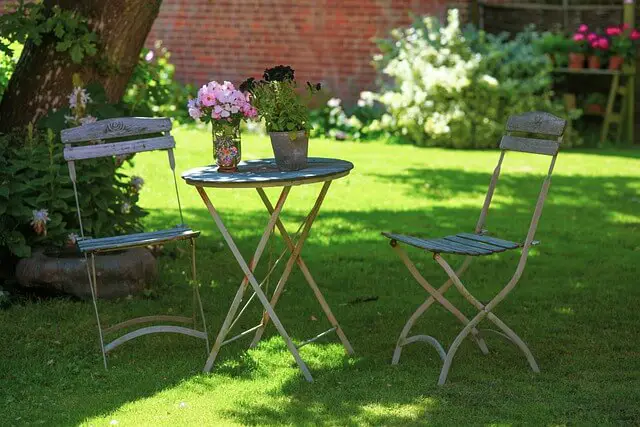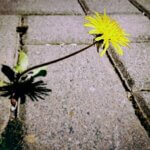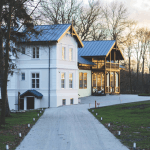The connotations of owning a shaded garden are often quite negative. Yet there are so many unique design opportunities available if you’re trying to make up for the lack of light entering your garden.
Next time you’re outdoors, try walking around a little bit in the sun, and then step indoors. You’ll notice that as your eyes begin to adjust to the changing light levels, you’ll perceive and process details, that you perhaps never noticed before. This is because your eyes need time to adjust to what’s around you and this can often take a little while.
These shifts in perception and light levels are precisely what gives shaded gardens their unique magic.
In this blog, we’re going to be exploring how you can make the most of your shaded back garden.
First Decide How Your Space Will Be Used
We all value our outdoor space for entirely different reasons – some may be for practical purposes such as growing vegetables or hanging the laundry out to dry; for recreational purposes such as playing with the kids; or simply as somewhere to kick back and relax.
By understanding your primary needs first and foremost, you can ensure that everything else you achieve thereafter is a bonus. This is an especially important step when you’re working in an area where space is at a premium.
You’ll likely have a least a small portion of the garden that does see a few hours of sunlight, so it’s essential to get your priorities in line – perhaps you need this space for a garden seat, to grow tomatoes or even wildflowers. However, if you’re looking to achieve these things, some activities simply won’t go hand in hand, such as playing with the kids and trying to grow delicate wildflowers at the same time, so it’s a case of making the most of what you have.
Utilising Colour in Darker Areas
Gorgeous flowers are usually the main attraction in sunny gardens, but they are often less prominent in a shaded garden. In the shade, foliage comes to the fore when the time comes to mix shapes, sizes, colours and textures.
In the shade, the dark reds and deep purples become less prominent, while the whites, yellows, lavenders and pinks automatically draw the eye. The shade makes the dark look darker but makes the bright look brighter.
Of course, this isn’t to say that flowers don’t have a place in shady areas. After all the colourful blossoms of begonias, primroses and foxgloves, are magnificent if you’re looking to contrast attention-grabbing flowers and lush foliage.
It’s also a good idea to periodically repeat colour patterns. Repetition is great for establishing a visual rhythm that ties the garden together.
Disperse Wind Patterns
Don’t be fooled into thinking that walls and fences create shelter for your garden. Wind can be a real problem for shady gardens since it is obviously naturally far cooler in areas that don’t see much sunlight.
Barriers like fences and walls tend to push strong air currents over and around the structure, which creates powerful wind tunnels. The impact of this can mean that this wind pressure can crush more delicate plants, and natural evaporation suffers due to colder temperatures.
Conversely, these solid blockades can also create problems when the wind is calmer since all the beneficial air is trapped on the other side of the barrier, which creates an ideal micro-climate for fungus and pests to thrive in.
Windbreaks such as foliage, trellis, slatted fences and hedging provide much greater protection, and will also provide aesthetic benefit too.
Draw the Eye
All well-designed gardens have one thing in common – they pull the eye to a specific focal point, that suggests the space is actually larger than it is.
A straight path leading to your tool shed, won’t offer such benefits. Curved edges and diagonal lines take the eye on longer, intriguing and more satisfying journey.
Even if this idea isn’t to your liking, there are so many other options that are capable of drawing the eye, such as sculptures, water ornaments, feature plants or decorative trellises.
Focus on Textures
In shady gardens, we are immediately drawn to the way the light patterns hit rich textured surfaces, such as velvety, glossy and smooth leaves. This is why it’s so important not to focus exclusively on colour; the texture will make all the difference.
Most hostas, for example, will have a bold, coarse feel, while dicentra, conifers and ferns, will give the impression of a fine, almost lace texture. Whatever plants you like the look of, always be sure to look for opportunities to emphasise textural contrasts, in the same way, you would with your colour choices.
Create Interesting Shapes
The best gardens use the shape of the plants themselves to guide a journey through space. For example, rounded, drooping, and spreading forms help to create a sense of fluidity, which is especially important in a shaded garden.
By placing similar or the same plant varieties next to each other, the eye will register them as a single shape. However, by placing different species together in irregular shapes and patterns, you create a sense of intrigue and variety.
Try to create combinations of single plants, groups and clumps and repeat them throughout the space, to retain that varietal intrigue.
Create Colour Bursts
A garden that relies on foliage will enjoy green and healthy-looking plants throughout every season. However, if you’re looking for bursts of colour, then flower bulbs are your best bet since they become almost accessories as they change colour throughout the year.
Spring bulbs such as snowdrops, daffodils and fritillaria are perfect for shady gardens because once they die back, they will naturalise and bloom again each year. Tulips are also strong performers in shady areas, as are spring perennials such as primroses and trillium.
Shrubs and small fruit trees, such as cherry and red currents are also particularly suited to shaded areas and will produce beautiful blooms in the spring and deep red fruits that attract wildlife as we move through summer.
Taking Care of Your Shaded Lawn
Raise the Height of Your Mower
Many of us like to keep our lawns short and well-manicured. However, if you have a shaded garden, it’s important to remember that the bigger the surface area the glass blade has, the more energy and sunlight it can harvest.
When sunlight is at a premium, your lawn will appreciate the chance to grow longer, not only does this help to pull in what sunlight is available, but it also helps to repel disease, caused by over mowing and damaging the grass blades.
Mowing Little and Often
Imagine that you’ve let your hair grow into long, flowing locks, and then suddenly decided that a shorter do is more your cup of tea?
Once you look in the mirror for the first time after your haircut, it takes some time to get used too, doesn’t it?
This no different to your lawn; if you let it grow too long and then suddenly decide it needs to be cut short, the grass will need some time to get used to the change. And in some cases, it might cause permanent damage.
Sure, you might be able to get away with it in a sunny garden, because the swards themselves have a readily available energy source to fall back on, but with shady lawns, you’ll only end up weakening the plant.
Mow at least once a week and take no more than 20-25% of the length. For example, if your grass is about 5cm, cut it down to no more than 4cm.
Regular Feeds
To ensure that your lawn is given every opportunity to thrive, it’s crucial that it always has the correct nutrients available to it.
Be especially vigilant if your lawn is growing under large trees and shrubs since it will be sharing vital nutrients with its neighbour and may need an extra helping hand.
Winter feeds are absolutely crucial for shaded lawns, as it will help to build up a robust root system. During spring and summer, be sure to select a good quality feed and follow manufacturer instructions for the best results.
Water Management
There are two kinds of shade: dry and damp. Water management is crucial for either type – you don’t want your lawn to die of thirst, and conversely, you don’t want to encourage diseases by bogging it down in too much moisture.
The trick to managing this is to aerate your lawn every once in a while using an aerator, or a garden fork. These holes will either allow rainwater into dry soil or drain away excess moisture from already wet soil.
As we’ve already mentioned, it’s essential to try to encourage good airflow. In the same way that plants can attract pests when airflow is minimal, lawns can be overcome by diseases such as patch disease.
Choose Tolerant Grass Species
These days its more than possible to buy grass seed suited to various conditions, such as shade resistance. If you’re not sure how much seed you need in the shaded areas, which is often the case when a garden experiences both light and shaded areas, an online grass seed calculators are ideal.
This blog is written in conjunction and with the expert advise of Stephen Beal, who is a grass seed expert and the Sales & Marketing Manager at www.barenbrug.co.uk
 Guides4Homeowners Useful Information & Guides
Guides4Homeowners Useful Information & Guides






